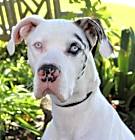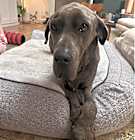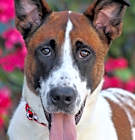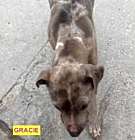Great Danes are giant dogs, most weighing 95 to 153 pounds and standing 29 to 35 inches tall, with males being larger than females.
Great Dane
Breed Type: Working
Common nicknames: Gentle Giant
Coat: Smooth
Hypoallergenic: No, they will likely trigger allergies.
Temperament: Gentle, affectionate, alert, intelligent
Life expectancy: 6-10 years
Color & patterns:

Looking for a canine companion who is larger than life? Look no further than the Great Dane. This breed is renowned for their towering height and imposing presence; Great Danes are one of the tallest breeds out there and can weigh up to a whopping 200 pounds. With their sleek coats and regal appearance, these gentle giants turn heads wherever they go. One of the things that sets Great Danes apart from other breeds is their quirky personalities. They may be big, but Great Danes are also big on fun; these dogs are endlessly entertaining and love to goof around. Their antics will keep you laughing. And while they may look intimidating, they’re incredibly friendly and love meeting new people (and dogs!). Their calm and friendly demeanor also makes them great with children and other pets.
Great Dane characteristics
Learn about about Great Dane basics like their fur colors, shedding levels, how much grooming they need, and other Great Dane facts.
Average height
29-35 inches (73.7-88.9cm)
Average weight
95-153 pounds (43.1-69.4 kg)
Average lifespan
6-10 years
Exercise needs
Grooming needs
Full-grown size
Good with cats
Good with kids
Training Aptitude
Do Great Danes have webbed feet?
Yes, Great Danes, like many other dog breeds, have webbed feet. Webbed feet are characterized by skin between the toes, which helps dogs swim more efficiently by providing additional surface area for propulsion in the water.
Do Great Danes drool?
Yes, Great Danes are known for their tendency to drool, especially after eating or drinking or when they are excited. This drooling is a result of their large jowls and deep chests, which can collect saliva.
Do Great Danes shed?
Yes, Great Danes are moderate to heavy shedders. Their short, smooth coats shed year-round, with heavier shedding occurring during seasonal changes, particularly in the spring and fall.
What is the rarest Great Dane color?
The rarest color pattern for Great Danes is the harlequin color pattern. Harlequin Great Danes have a white base coat with irregular black patches scattered over their body, resembling a marble or stained glass effect.
What color are Great Danes?
Great Danes come in a variety of colors, including fawn and brindle, black, harlequin, mantle, and blue.
What does a Great Dane look like?
Great Danes are known for their majestic appearance and imposing stature. Great Danes have a short, smooth coat, a large, muscular build, deep chest, and long, elegant neck. Their head is proportionate to their body, with a distinctive square-shaped muzzle and a pronounced stop. Their ears are medium in size, usually left natural or, historically, have been cropped to stand erect. However, ear cropping is a controversial practice and has been banned or restricted in many countries due to animal welfare concerns. There is no medical reason to crop a dog’s ears, and vets do not recommend it.
How long do Great Danes live?
Great Danes typically have a lifespan of around seven to 10 years. However, like all breeds, individual dogs may vary, and factors such as genetics, diet, exercise, and healthcare can influence their longevity.
When do Great Danes stop growing?
Great Danes are considered a giant breed and typically undergo a significant growth spurt during their first year of life. Most Great Danes will reach their full height by around 18 months old, although they may continue to fill out and gain muscle mass until they are around two to three years old.
Are Great Danes bigger than Irish Wolfhounds?
Yes, Great Danes are generally larger than Irish Wolfhounds in terms of height and weight. While both are considered large or giant breeds, Great Danes typically have a heavier build and stand taller at the shoulder. On average, Great Danes can reach heights of 28 to 32 inches at the shoulder and weigh between 110 to 175 pounds, while Irish Wolfhounds typically stand between 30 to 32 inches at the shoulder and weigh between 140 to 180 pounds.
Great Dane history
Learn about where this Great Dane came from!
What were Great Danes bred for?
Great Danes were originally bred for hunting purposes, particularly for hunting large game such as boars. Their imposing size, strength, and agility made them well-suited for this task. Additionally, their keen senses and determination made them effective hunters.
Where are Great Danes from?
Like all Mastiff breeds, the Great Dane’s origins are in Asia. The Great Dane is thought to be an 1800s cross-breed between the Irish Wolfhound or local Greyhounds and the English Mastiff. In the 16th century, it became popular for European royalty to import these leggy dogs from England.
Great Dane temperament
Learn about about the Great Dane temperament and how well they fit into your lifestyle, home environment, and family.
Are Great Danes good with kids?
Yes, Great Danes are known as “gentle giants” and are generally sweet with children, especially when socialized with them at a young age. As with any breed, it is recommended that your child is always supervised when interacting with your Great Dane to keep both the child and dog safe. Teaching children how to properly approach and handle dogs is also crucial to ensure positive experiences for both the dog and the child, as is teaching dogs how to interact gently with children.
Are Great Danes easy to train?
Yes, Great Danes are easy to train. Training is very much required or this breed will feel free to live up to its moniker as the “world’s largest lap-dog.” This breed doesn't know their own strength or size, so must be taught to be physically deferential to their pet parents.
Just keep in mind that even if a certain dog breed is known to be easy to train, teaching a dog requires a long-term commitment.
Do Great Danes bark a lot?
No, Great Danes don’t frequently bark, but when they do, their howls pack a punch. However, as with any dog, they can be discouraged from barking with proper training and exercise.
Are Great Danes good dogs?
Yes, Great Danes are good dogs. They are affectionate and gentle and don’t require as much exercise as you might expect from a giant dog. They (obviously) take up a lot of room, so they’re not ideal for small apartment living, and they do slobber quite a bit, so stock up on towels.
Are Great Danes good with cats?
Yes, Great Danes can get along well with cats as they do not have a high prey drive. Of course, each dog has his own preferences and temperament, but you can feel fairly confident your Great Dane, if properly socialized to your cat and/or introduced at a young age, should get along just swell.
Are Great Danes good with other dogs?
Yes, many Great Danes have gentle and friendly dispositions and can get along well with other dogs. Early socialization, positive experiences, and proper training are crucial for ensuring that Great Danes develop good manners and positive interactions with other dogs. As with any large breed, it’s essential to supervise interactions between Great Danes and smaller dogs, especially puppies, to prevent accidental injuries due to the size and strength difference.
Are Great Danes smart?
Yes, Great Danes are generally considered smart dogs. They are known for their alertness, quick learning, and ability to pick up on cues from their environment and their human companions.
Are Great Danes good guard dogs?
No, Great Danes are not generally good guard dogs. While they are known for their imposing size and strength, unlike breeds specifically bred for guarding and protection, such as German Shepherds or Rottweilers, Great Danes tend to be more gentle and sociable. However, their sheer presence and deep bark can act as a deterrent to potential intruders.
Do Great Danes like to cuddle?
Yes, many Great Danes enjoy cuddling with their pet parents and are known for their affectionate nature. Despite their large size, they often see themselves as lap-dogs and may try to snuggle up with their family members on the couch or bed. Great Danes are typically gentle and loving dogs, and they often seek out physical closeness and comfort from their human companions.
Can Great Danes be service dogs?
Yes, Great Danes can be trained as service dogs. While they may not be as commonly seen in service roles as some other breeds, such as Labradors or Golden Retrievers, they possess many qualities that can make them well-suited for certain types of service work.
Can Great Danes swim?
Yes, Great Danes can swim, but they may not be as proficient in the water as some other breeds. Their large size and heavy build can make swimming more challenging for them compared to smaller, more buoyant breeds.
Are Great Danes good apartment dogs?
Great Danes can adapt to apartment living, but it’s important to consider their size and exercise needs when deciding if they are a suitable fit for apartment living. Great Danes are generally calm and well-mannered indoors, making them potentially good apartment dogs in terms of behavior. They are typically content to lounge around the house and are not overly active indoors. However, their large size means that they require ample space to move around comfortably, even when indoors.
Great Dane health
Learn about about the Great Dane health outlook and what diseases they may be prone to at various stages of their life.
Do Great Danes have health problems?
Great Danes are generally healthy, though they do have a regrettably short lifespan, usually living around eight years. They may experience other health problems, including:
Hip and elbow dysplasia: Hip and elbow dysplasia are two of the most common skeletal diseases seen in dogs. They are similar diseases in which either the hip or elbow joint has grown abnormally or is misshapen. The abnormal shape prevents the joints and sockets from properly meeting one another, resulting in rubbing and grinding instead of sliding smoothly. Unlike in hip dysplasia, where the main problem is joint instability, the abnormalities seen in elbow dysplasia often result in pieces of bone and/or cartilage breaking loose and irritating the joint tissues. Over time, the rubbing from dysplasia can cause a variety of issues, such as pain, lameness, and secondary osteoarthritis. Surgery can be done to fix the joint if diagnosed before the onset of arthritis. If you are rescuing a Great Dane, have them checked out by a vet to see if they have or are prone to getting dysplasia so you know what they will be able to handle in terms of activities and exercise.
Gastric dilatation-volvulus (GDV): Also known as bloat, this is the number one killer of Great Danes. Bloat is a sudden and life-threatening swelling of the abdomen. The swelling is caused by gas or air building up in the stomach and then twisting (torsion). Recognizing the symptoms of bloat is very important. If you see your dog throw up bile or hack without producing any vomit, pace, or if his stomach is visibly larger, get her to the vet immediately. Her abdomen will likely be tight and painful to the touch.
Heart disorders: The Great Dane is nicknamed the “heartbreak breed” due to its high incidence of congenital heart defects, which are in large part to blame for their short average lifespan. Dilated cardiomyopathy is one of the leading heart issues in Great Danes.
Others: Slow metabolism and bone cancer also affect the Great Dane.
Do Great Danes get cold easily?
Great Danes are not particularly well-suited to cold weather due to their short coat and lean body structure. They have minimal insulation against the cold compared to breeds with thicker coats or more body fat.
Are Great Danes hypoallergenic?
No, Great Danes are not considered hypoallergenic dogs. They have short, smooth coats that shed moderately year-round, which can release dander and trigger allergies in susceptible individuals. Additionally, Great Danes produce saliva and skin oils that can also contain allergens.
Do Great Danes need a lot of exercise?
Great Danes do not require excessive amounts of exercise compared to some other breeds, but they still benefit from regular physical activity to maintain their health and well-being. Daily walks and opportunities to stretch their legs are essential for keeping them mentally and physically stimulated. Moderate exercise, such as leisurely walks or play sessions in a fenced yard, is generally sufficient to meet the needs of most Great Danes.
Popular Great Dane mixes
Breeds that mix with Great Danes include Labradors and Irish Wolfhounds. Other breeds that mix well with Great Danes include:
Labradane (Great Dane + Labrador)
Great Wolfhound (Great Dane + Irish Wolfhound)
American Bulldane (Great Dane + American Bulldog)
Boxdane (Great Dane + Boxer)

Find Great Dane puppies near you
Adopting a Great Dane
Learn about acquiring a Great Dane - the pros and cons of adopting versus going through a breeder, and associated costs.

Turbo
Great Dane
Male, 2 yrs 2 mos
Valley Glen, CA
Good with dogs
Not good with cats
House-trained
Spayed or Neutered
Shots are up-to-date

MARMADUKE
Great Dane
Male, young
Los Angeles, CA
Not good with dogs
Not good with cats
House-trained
Spayed or Neutered

Buffalo
Great Dane
Male, 9 yrs
Marina del Rey, CA
Not good with dogs
Not good with cats

Zeus
Great Dane Cattle Dog
Male, young
Los Angeles, CA
Good with dogs
Good with cats
House-trained
Spayed or Neutered
Shots are up-to-date

Halo Moon
Great Dane
Female, 9 mos
Inglewood, CA
Good with dogs
Not good with cats

Chantilly
Great Dane
Female, 7 yrs
Inglewood, CA
Good with dogs
Not good with cats
Spayed or Neutered

GRACIE
Great Dane
Female, adult
Woodland Hills, CA
Not good with dogs
Not good with cats
House-trained
Spayed or Neutered

Zena A2019230
Great Dane
Female, 6 yrs 1 mo
Mission Hills, CA
Not good with dogs
Not good with cats
Spayed or Neutered

Turbo
Great Dane
Male, 2 yrs 2 mos
Valley Glen, CA
Good with dogs
Not good with cats
House-trained
Spayed or Neutered
Shots are up-to-date

MARMADUKE
Great Dane
Male, young
Los Angeles, CA
Not good with dogs
Not good with cats
House-trained
Spayed or Neutered

Buffalo
Great Dane
Male, 9 yrs
Marina del Rey, CA
Not good with dogs
Not good with cats

Zeus
Great Dane Cattle Dog
Male, young
Los Angeles, CA
Good with dogs
Good with cats
House-trained
Spayed or Neutered
Shots are up-to-date

Halo Moon
Great Dane
Female, 9 mos
Inglewood, CA
Good with dogs
Not good with cats

Chantilly
Great Dane
Female, 7 yrs
Inglewood, CA
Good with dogs
Not good with cats
Spayed or Neutered




